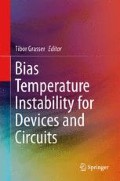Abstract
This chapter introduces a new experimental approach allowing to switch the temperature of a device in a very fast and defined way. The new hardware tool, which we will herein refer to as polycrystalline silicon heater or simply poly-heater, allows overcoming previously strict experimental limitations regarding the speed of temperature variation and the accessibility of temperature range. Having broadened one’s mind to the possibility of switching the temperature very fast at arbitrary points in time, the poly-heater technique opens up unprecedented experimental capabilities for bias temperature instability (BTI) characterization. For instance, one can achieve decoupling of stress and characterization temperature by making use of degradation quenching. Such or similar experiments can probe our understanding of the BTI physics in a novel manner.
Access this chapter
Tax calculation will be finalised at checkout
Purchases are for personal use only
References
W. Muth, W. Walter, in Proc.ESSDERC (2007), pp. 1251–1262
C. Schluender, R.P. Vollertsen, W. Gustin, H. Reisinger, in Proc.ESSDERC (2007), pp. 131–134
T.K. Kang, C.S. Wang, K.C. Su, Jpn.J.Appl.Phys. 46, 7639 (2007)
C.S. Wang, W.C. Chang, W.S. Ke, C.T. Chiang, C.F. Lee, K.C. Su, in Proc.SSDM (2005), pp. 580–581
C.S. Wang, W.C. Chang, W.S. Ke, K.C. Su, in Proc.IIRW (2006), pp. 136–138
H. Köck, V. Košel, C. Djelassi, M. Glavanovics, D. Pogany, Microelectron.Reliab. 49, 1132 (2009)
A. Kelleha, W. Lane, IEEE Trans.Nucl.Sci. 43, 997 (1996)
W. Liu, M. Asheghi, J. Appl. Phys. 98, 123523 (2005)
A. Cardoso, A.K. Srivastava, J. Vac. Sci. Tech. B 19, 397 (2001)
H. Ibele, K. Reitinger, in IEEE Semiconductor Wafer Test Workshop (2005)
P. Leturcq, J.M. Dorkel, A. Napieralski, E. Lachiver, Trans. Elec. Dev. 34, 1147 (1987)
C.J. Glassbrenner, G.A. Slack, Phys. Rev. 134, A1058 (1964)
G.A. Slack, J. Appl. Phys. 35, 3460 (1964)
T. Aichinger, M. Nelhiebel, T. Grasser, in Proc.ESREF (2008), pp. 1178–1184
T. Aichinger, M. Nelhiebel, T. Grasser, in Proc.IRPS (2009), pp. 2–7
H. Reisinger, O. Blank, W. Heinrigs, A. Mühlhoff, W. Gustin, C. Schlünder, in Proc.IRPS (2006), pp. 448–453
B. Kaczer, V. Arkhipov, R. Degraeve, N. Collaert, G. Groeseneken, M. Goodwin, in Proc.IRPS (2005), pp. 381–387
G. Pobegen, T. Aichinger, M. Nelhiebel, T. Grasser, in IEDM Tech. Dig. (2011), pp. 27.3.1–27.3.4
B. Tuttle, Phys.Rev.B 59, 12884 (1999)
S. Ganichev, E. Ziemann, W. Prettl, I. Yassievich, A. Istratov, E. Weber, Phys.Rev.B 61, 61 (2000)
W. Gös, M. Karner, S. Tyaginov, P. Hehenberger, T. Grasser, in Proc.SISPAD (2008), pp. 69–72
Acknowledgements
This work was jointly funded by the Austrian Research Promotion Agency (FFG, Project No. 831163) and the Carinthian Economic Promotion Fund (KWF, contract KWF-1521|22741|34186).
Author information
Authors and Affiliations
Corresponding author
Editor information
Editors and Affiliations
Rights and permissions
Copyright information
© 2014 Springer Science+Business Media New York
About this chapter
Cite this chapter
Aichinger, T., Pobegen, G., Nelhiebel, M. (2014). Application of On-Chip Device Heating for BTI Investigations. In: Grasser, T. (eds) Bias Temperature Instability for Devices and Circuits. Springer, New York, NY. https://doi.org/10.1007/978-1-4614-7909-3_2
Download citation
DOI: https://doi.org/10.1007/978-1-4614-7909-3_2
Published:
Publisher Name: Springer, New York, NY
Print ISBN: 978-1-4614-7908-6
Online ISBN: 978-1-4614-7909-3
eBook Packages: EngineeringEngineering (R0)

